The SMART Storage Systems CloudSpeed 500 is an entry enterprise SSD with SATA interface designed to meet the needs read-intensive scenarios such as boot drive, workstations and certain embedded applications. The CloudSpeed 500 uses a SandForce controller paired with 24nm MLC NAND to deliver not just high throughput, but also high endurance. It can be difficult to differentiate with SandForce-based SSDs, as the build and firmware are rarely novel. With that in mind, Smart’s hook with the CloudSpeed 500 is the endurance. Smart touts 15,000 PE cycles, which is more than some other SandForce-based offerings, and it does this all while preserving capacity with just 7% over-provisioning. The drive also offers power-fail protection to ensure in-flight data makes it to its destination during a power loss event.
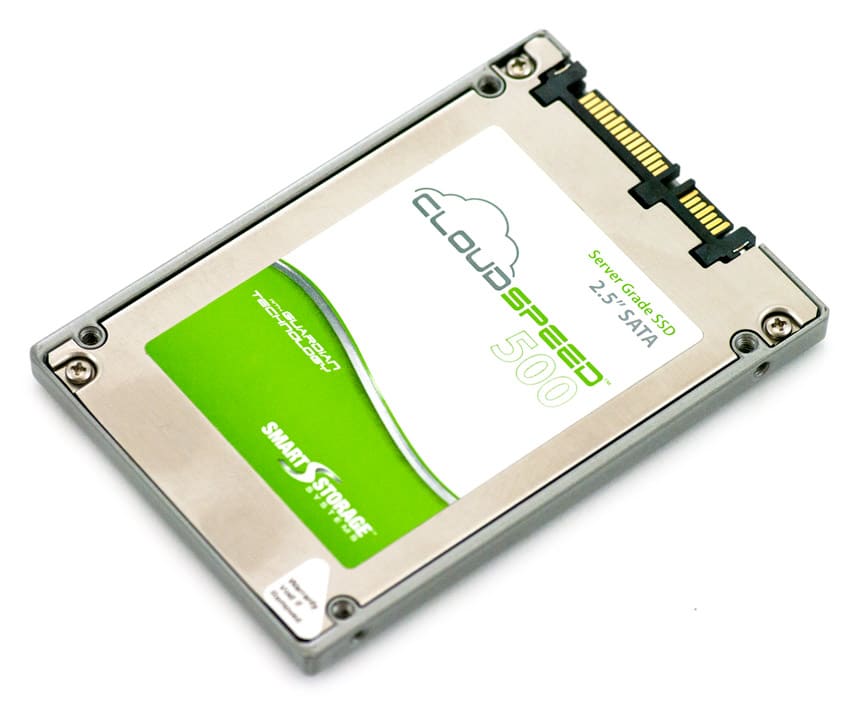
The CloudSpeed 500 positions itself within a market that has at times relied on using client SSDs to meet their needs because of the low cost. Client SSDs saw tremendous uptake in servers as boot drives, in caching solutions and some all SSD flash arrays where it was cheaper to throw away a client SSD than to invest in an enterprise drive. However, client SSDs lack endurance, predictable long-term performance and other features such as power-fail protection that can often be found even within entry-enterprise drives. SSDs like the CloudSpeed 500 essentially are part of this new wave of entry enterprise models that try to keep prices reasonable while offering a complete set of enterprise features.
In this particular slice of the enterprise market though, there are a number of offerings that cloud the issue of where one sub-market starts and another stops. When we think about mainstream enterprise SSDs there are two sub-markets; one is addressed with a client SSD or a client SSD repurposed via firmware to address largely read-intensive workloads with a low cost. The second is a step up and the SSDs address workloads that are defined as mission critical while adding additional features like power fail protection and higher endurance. This second category defines the CloudSpeed 500 well from a feature set perspective, though the drive also fits in the low-cost first category too, making it a unique offering in the space.
When compared to the client drives the CloudSpeed 500 could face, Smart pitches endurance as the key differentiator. The CloudSpeed 500 is rated for 15,000 PE cycles, which compares favorably to client drives that are generally rated for 3,000 to 5,000 PE cycles. That translates into an endurance figure of roughly 525TBW (1.2 full drive writes per day) of random writes over the five year warranty of the 240GB drive. Compared to the SSDs targeting the entry-enterprise market, that endurance puts the drive well ahead of most.
The Smart Storage Systems CloudSpeed 500 SSD comes in capacities at 120GB, 240GB and 480GB, all with an industry-standard five year warranty. Our review model is the 240GB capacity.
Smart Storage Systems CloudSpeed 500 Specifications
- Capacities
- 120GB (TG32C10120GK3001)
- 240GB (TG32C10240GK3001)
- 480GB (TG32C10480GK3001)
- Performance
- Burst 600MB/s
- Sustained Read/Write Up to 500MB/s
- Random IOPS Read/Write Up to 60K/20K
- Access Time < 1.0ms
- SATA 6Gb/s, 2.5” form factor
- Endurance for Mixed Workload – Guardian Technology: 1.2 full random drive writes/day
- 15,000 P/E Cycles
- Data Fail Protection: Recover up to 1 NAND flash erase block of data
- High-reliability backup-power circuitry
- Performance throttling upon warning/critical temperature
- Power
- Vcc 5V ± 5%
- Active 1.2 A (Typical)
- Idle 0.5 A (Typical)
- Environmental
- Shock (operating) 200g half-sine, 10msec, 1 shock along each axis, X, Y, Z, in each direction
- Vibration (operating) 0.67 g rms 5 – 500 Hz, 3 axes
- Operating Temperature 0°C to 70°C (Internal)
- Storage Temperature -40°C to 70°C
- Humidity 5% to 95%, non-condensing, relative humidity
- Altitude 24,384m (80,000 ft)
- Dimensions (LxWxH) 100.2 mm x 69.85 mm x 7 mm
- 5 Year Warranty
Design and Build
The front of the CloudSpeed 500 employs a label to cover the top while leaving the metallic gray edges exposed. The casing also has visible screw holes to disassemble to drive. On the bottom of the SSD, we can see the CloudSpeed 500’s standard barcode sticker that includes drive information.
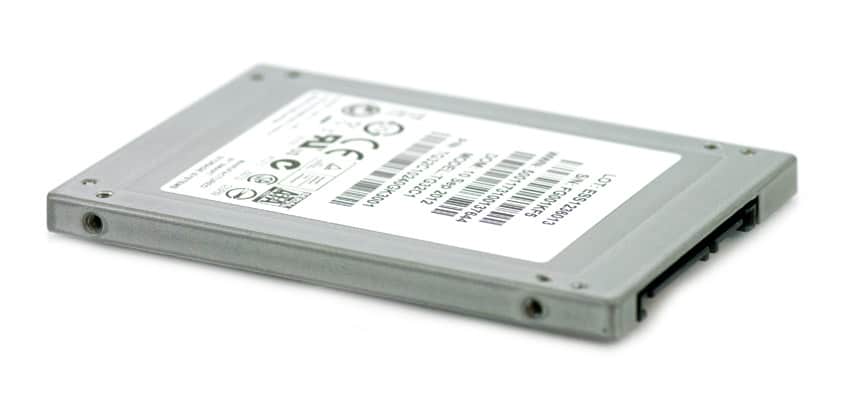
Moving to the side profile, we can see the screw holes that provide users the ability to mount the drive. As for form factor size, the drive comes in a 2.5" form factor with slim 7mm height that enables it to fit a wide array of applications and reduces footprint.
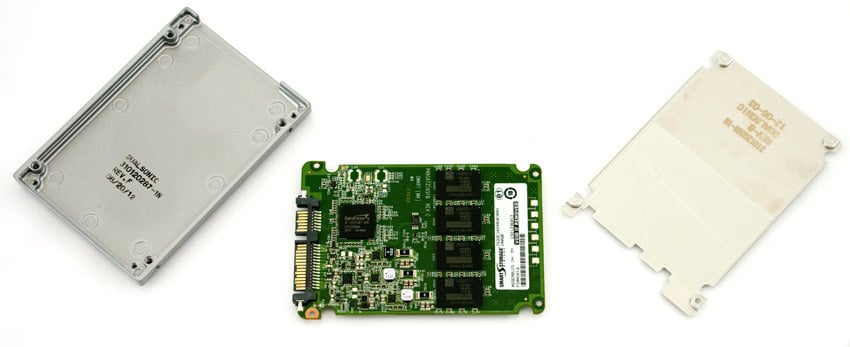
The Smart Storage Systems CloudSpeed 500 incorporates a SandForce SF-2581 controller and 8 24nm MLC NAND die in 32GB NAND packages. This gives the SSD a total capacity of 256GB, with 240GB of usable storage when the minor 7% over-provisioning is accounted for. The MLC NAND helps to keep the build cost low, and as we mentioned above, the CloudSpeed 500’s firmware and engineering increase the endurance of the SSD which is rated up to 15,000 PE cycles. The only item not seen inside the CloudSpeed 500 is a thermal pad to draw heat away from the controller and/or NAND, which we normally find within enterprise SSDs.
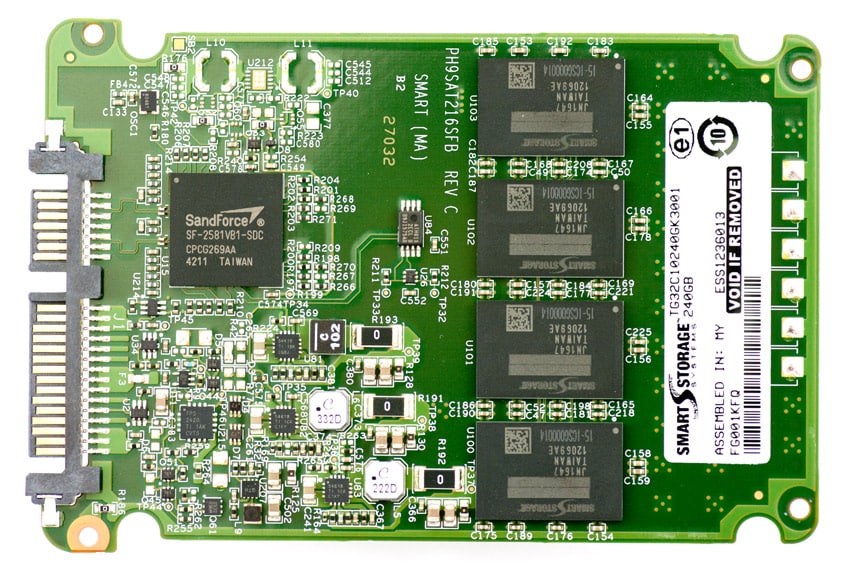
On the Smart Storage Systems CloudSpeed 500 PCB, we can see the included power-fail capacitors that protect data in-flight if power is unexpectedly lost to the drive.
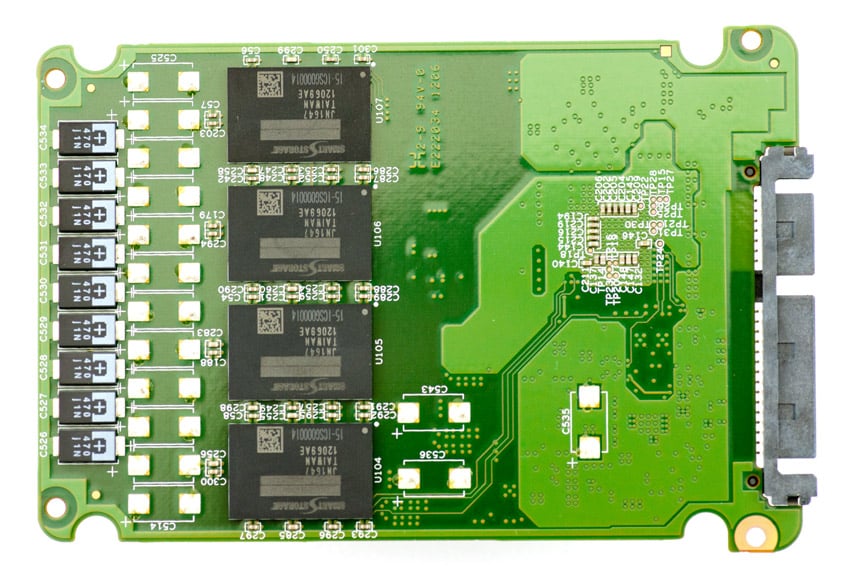
Testing Background and Comparables
The Smart Storage CloudSpeed 500 240GB uses 24nm MLC NAND and a SandForce SF-2581 controller with a SATA 6.0Gb/s interface. The comparables below were selected based on price and likelihood of being found in the targeted entry-enterprise market.
Comparables for this review:
- Micron M500 480GB (480GB, Marvell 9187 controller, Micron 20nm MLC NAND Flash, 6.0Gb/s SATA)
- Micron M500 960GB (960GB, Marvell 9187 controller, Micron 20nm MLC NAND Flash, 6.0Gb/s SATA)
- Samsung SSD 840 Pro (512GB, 300mhz Samsung 3-core MCX controller, Samsung 2Xnm Toggle NAND Flash, 6.0Gb/s SATA)
- Samsung SM843 (240GB, 300mhz Samsung 3-core MCX controller, Samsung 2Xnm Toggle NAND Flash, 6.0Gb/s SATA)
- Intel SSD 520 (240GB, SandForce SF-2500 controller, Intel 25nm MLC NAND Flash, 6.0Gb/s SATA)
All SAS/SATA enterprise SSDs are benchmarked on our second-generation enterprise testing platform based on a Lenovo ThinkServer RD630. This new Linux-based testing platform includes the latest interconnect hardware such as the LSI 9207-8i HBA as well as I/O scheduling optimizations geared towards best-case flash performance. For synthetic benchmarks, we utilize FIO version 2.0.10 for Linux and version 2.0.12.2 for Windows.
- 2 x Intel Xeon E5-2620 (2.0GHz, 15MB Cache, 6-cores)
- Intel C602 Chipset
- Memory – 16GB (2 x 8GB) 1333Mhz DDR3 Registered RDIMMs
- Windows Server 2008 R2 SP1 64-bit, Windows Server 2012 Standard, CentOS 6.3 64-Bit
- 100GB Micron RealSSD P400e Boot SSD
- LSI 9211-4i SAS/SATA 6.0Gb/s HBA (For boot SSDs)
- LSI 9207-8i SAS/SATA 6.0Gb/s HBA (For benchmarking SSDs or HDDs)
- Mellanox ConnectX-3 10GbE PCIe 3.0 Adapter
- Mellanox ConnectX-3 InfiniBand PCIe 3.0 Adapter
Application Performance Analysis
In the enterprise market there is a huge difference between how products perform on paper and how they perform in a production environment. At StorageReview we understand the importance of expanding into Application testing, with our first test being our MarkLogic NoSQL Database Storage Benchmark. While synthetic tests will continue to be an important part of our reviews, we plan on expanding our application tests to cover a wide range of areas, including VDI performance, VM load generation, expanded database performance tests, and many other areas.
In our MarkLogic NoSQL Database environment, we test groups of four SATA or SAS SSDs with a usable capacity greater than or equal to 200GB. Our NoSQL database requires roughly 650GB of free space to work with, evenly divided between four database nodes. In our testing environment, we use an SCST host and present each individual SSD in JBOD, with one allocated per database node. The test repeats itself over 24 intervals, requiring between 30-36 hours total for the SSDs in this category. Measuring the internal latencies seen by the MarkLogic software, we record both total average latency, as well as interval latency for each SSD.
The Smart CloudSpeed 500 is the first drive in the entry-enterprise SSD segment we’ve run through the MarkLogic NoSQL test. It averaged an overall latency of 11.058ms, which was very good, and put it into the performance range of mainstream enterprise SSDs.

Looking at the overall average latency in each area we measured, we recorded peaks as high as 1,907ms, with many peaks measuring between 60-100ms.
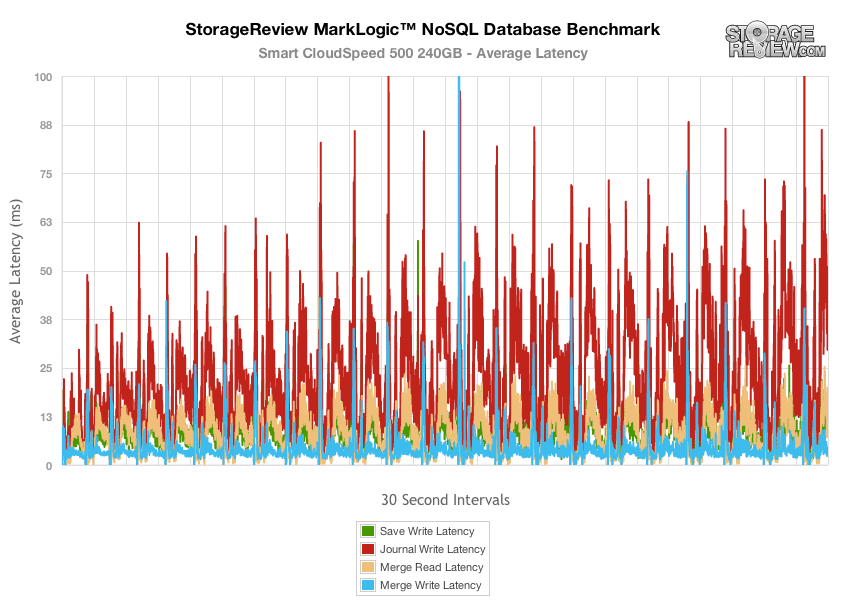
Enterprise Synthetic Workload Analysis
Flash performance varies throughout the preconditioning phase of each storage device. Our enterprise storage benchmark process begins with an analysis of the way the drive performs during a thorough preconditioning phase. Each of the comparable drives are secure erased using the vendor’s tools, preconditioned into steady-state with the same workload the device will be tested with under a heavy load of 16 threads with an outstanding queue of 16 per thread, and then tested in set intervals in multiple thread/queue depth profiles to show performance under light and heavy usage.
Preconditioning and Primary Steady-State Tests:
- Throughput (Read+Write IOPS Aggregate)
- Average Latency (Read+Write Latency Averaged Together)
- Max Latency (Peak Read or Write Latency)
- Latency Standard Deviation (Read+Write Standard Deviation Averaged Together)
Our Enterprise Synthetic Workload Analysis includes four profiles based on real-world tasks. These profiles have been developed to make it easier to compare to our past benchmarks as well as widely-published values such as max 4k read and write speed and 8k 70/30, which is commonly used for enterprise drives. We also included two legacy mixed workloads, the traditional File Server and Webserver, each offering a wide mix of transfer sizes.
- 4k
- 100% Read or 100% Write
- 100% 4k
- 8k 70/30
- 70% Read, 30% Write
- 100% 8k
- File Server
- 80% Read, 20% Write
- 10% 512b, 5% 1k, 5% 2k, 60% 4k, 2% 8k, 4% 16k, 4% 32k, 10% 64k
- Webserver
- 100% Read
- 22% 512b, 15% 1k, 8% 2k, 23% 4k, 15% 8k, 2% 16k, 6% 32k, 7% 64k, 1% 128k, 1% 512k
Our first test measures 100% 4k random write performance with a load of 16T/16Q. In this setting, the bursting nature of the Smart Storage CloudSpeed 500 240GB tested at 40,000 IOPS, which positions near the Intel SSD 520. The CloudSpeed 500 then leveled off near 3,300 IOPS as it entered steady-state. This placed it near the bottom of the pack.
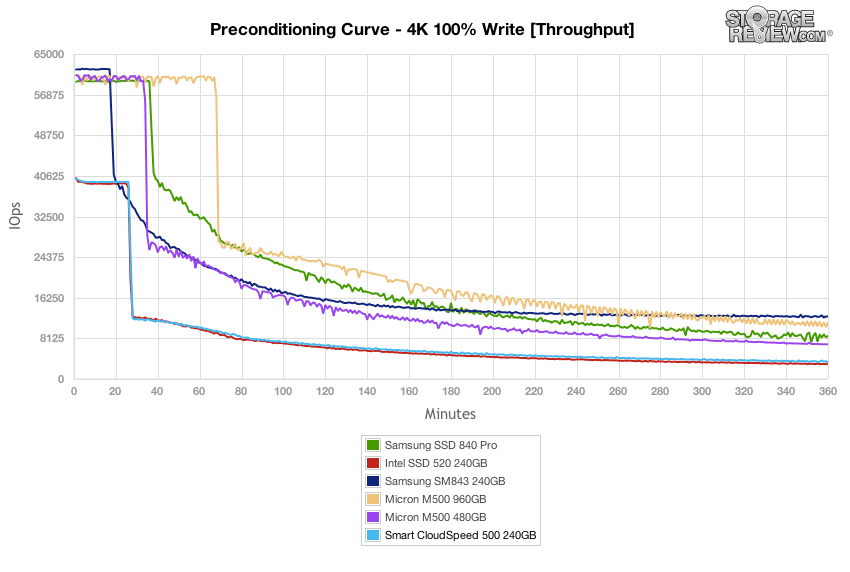
With a heavy 16T/16Q load, the CloudSpeed 500 240GB measured 6.34ms in burst and scaled up to 77.42ms as it neared steady-state. The CloudSpeed 500 was at the bottom of the pack, but still above the Intel SSD 520.
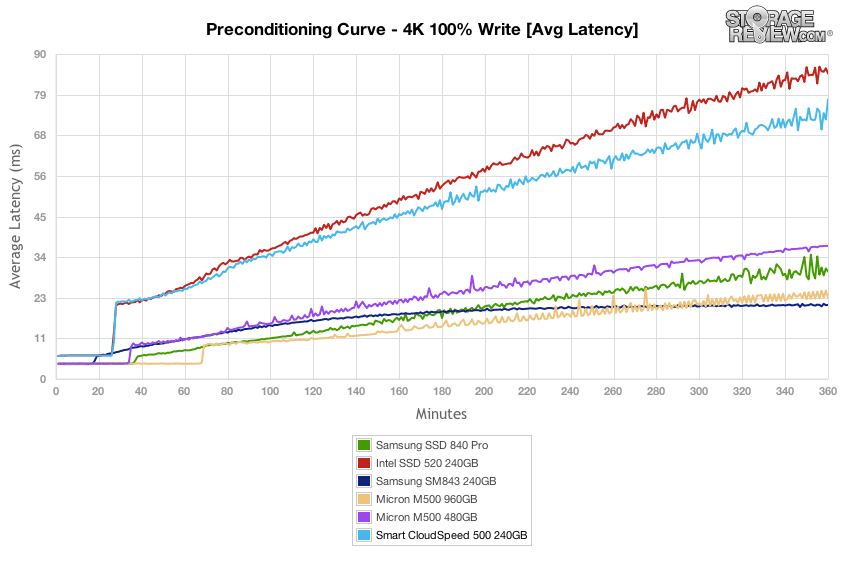
Comparing max latency between the SSDs, the CloudSpeed 500 240GB had max response times ranging between 150-280ms in steady-state, which was less consistent than the Intel 520, but near the same solid marks.
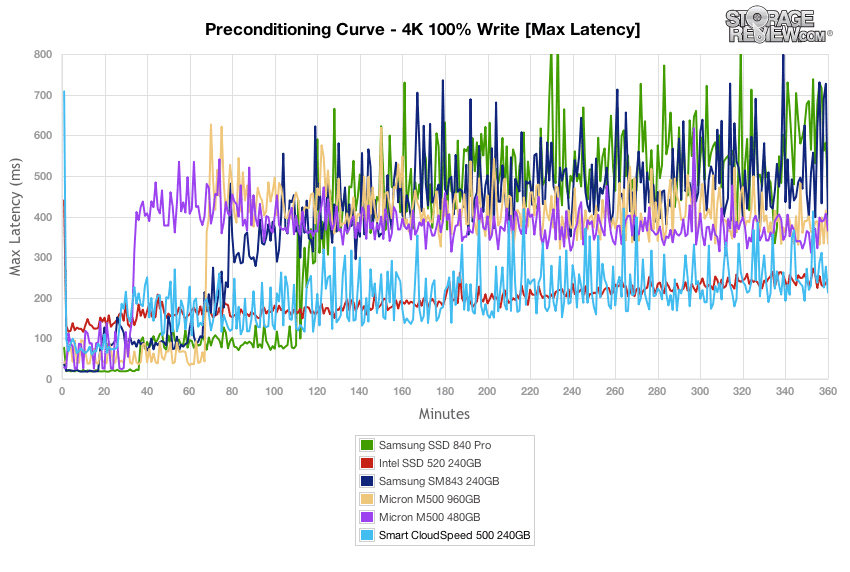
Looking even closer at the latency consistency in our 4k random write workload, the CloudSpeed 500 240GB was in the middle of the pack.
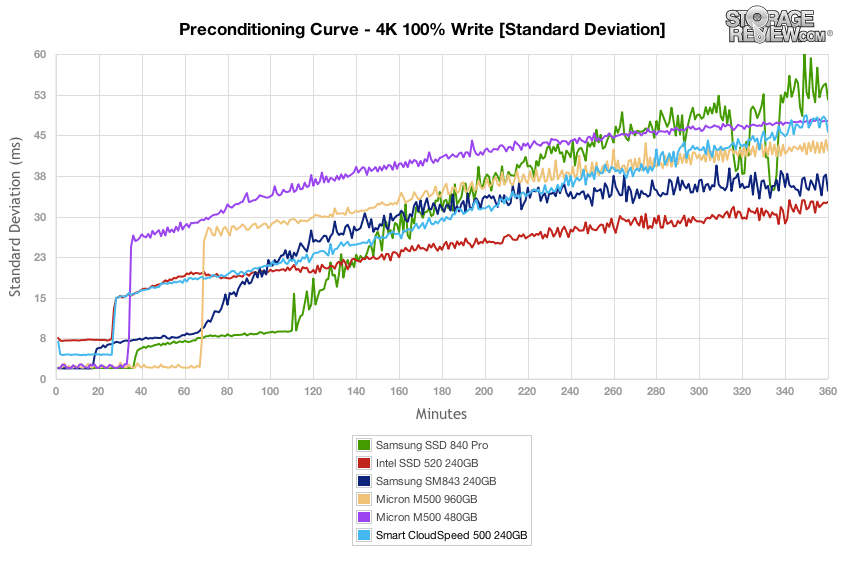
After 6 hours of preconditioning, the CloudSpeed 500 offered middle of the pack 4k random read performance at 47,300 IOPS, and its write speed was only stronger than the Intel 520 at 3,300 IOPS.
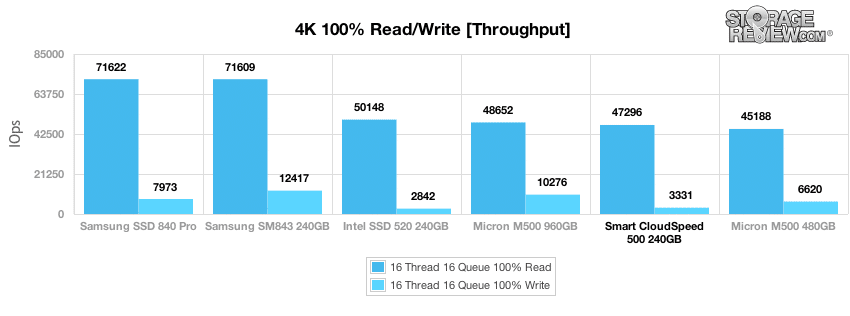
With a heavy load of 16T/16Q, the Samsung drives were very strong while the CloudSpeed 500 offered middle of the group read latency at 5.41ms and write latency only besting the Intel 520 at 76.85ms.
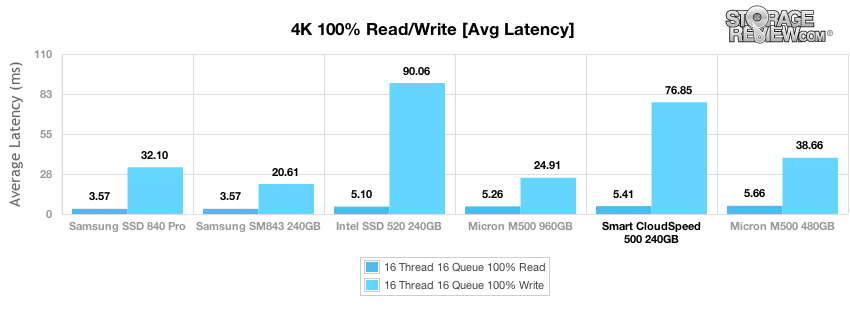
As we look at max latency in our 4k test, the CloudSpeed 500 had superb max write latency at 268ms, but it’s read latency was on the higher end of the group.
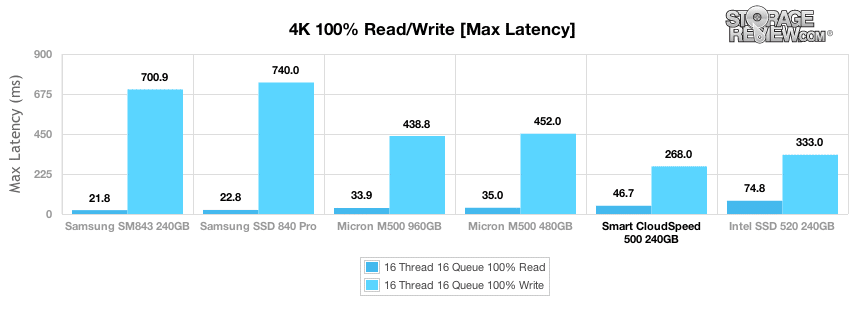
The CloudSpeed 500 read latency standard deviation was average by comparison, and the writes at 48.90ms were near the bottom-middle of the group.
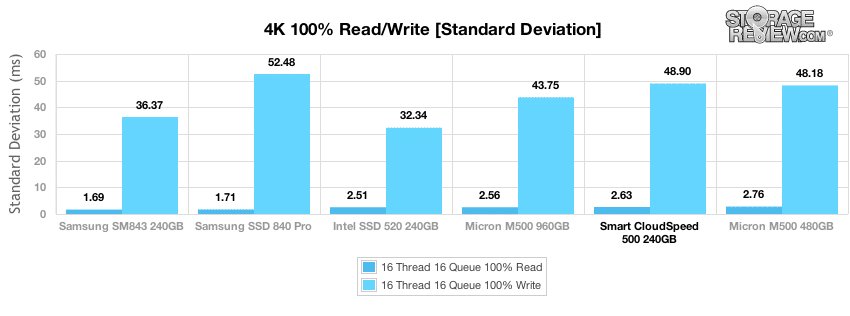
In our first mixed workload using an 8k profile 70/30% read/write spread and a constant 16T/16Q load, we measured a peak rate of 37,700 IOPS from the CloudSpeed 500 before it hit steady-state at around 6,400 IOPS. The chart shows that the Micron M500 960GB stayed in burst the longest and offered the most consistent IOPS.
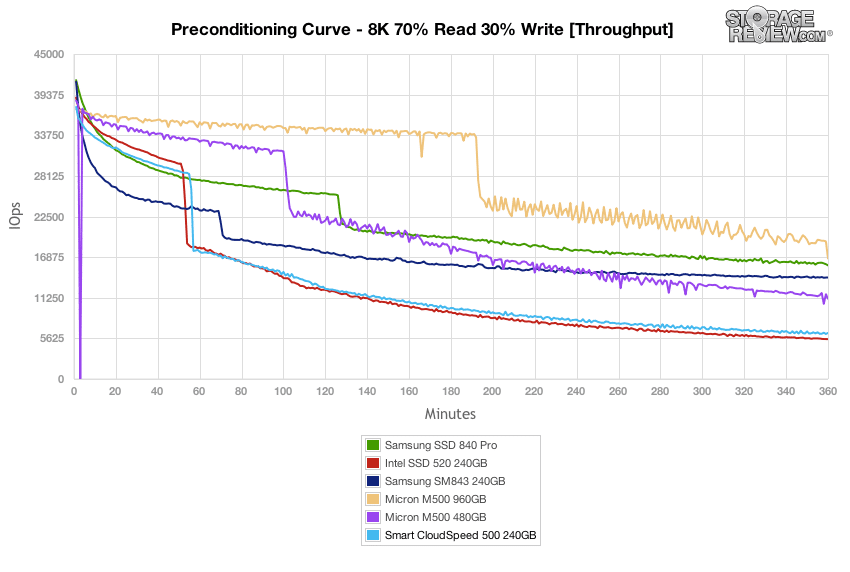
With a load of 16T/16Q, the CloudSpeed 500 offered an average latency of around 6.75ms in burst before increasing to 40.15ms as it arrived at steady-state. This was comparable to the Intel 520, but near the bottom of the group.
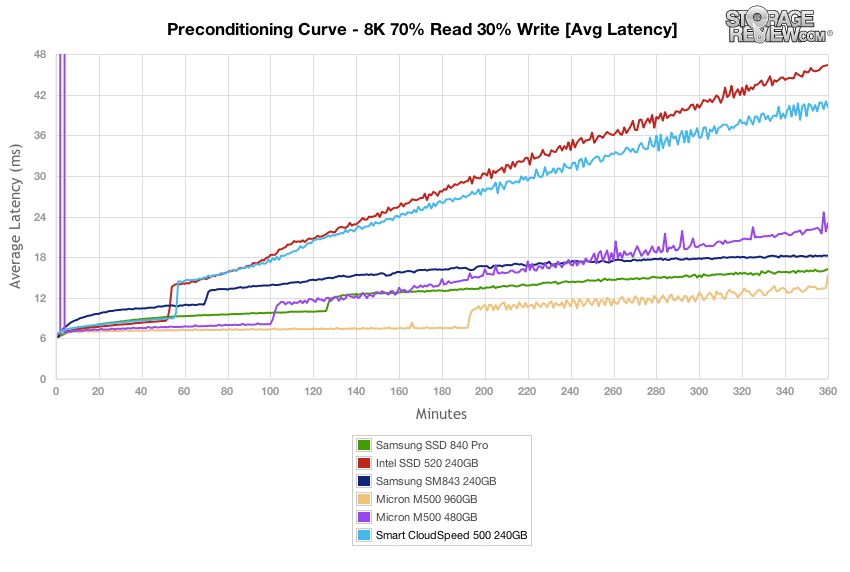
In the max latency section of our 8k 70/30 preconditioning test, the CloudSpeed 500 measured between 200-280ms in steady-state, placing it in the middle of the pack that was again led by the Samsung drives.
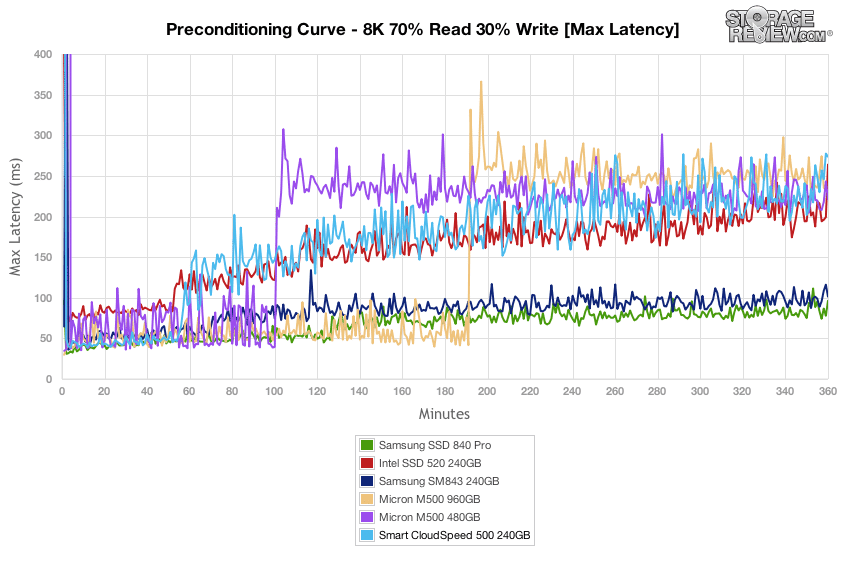
When the CloudSpeed 500 got to steady-state, it tested competitively with the Micron M500 480GB and the Intel 520.
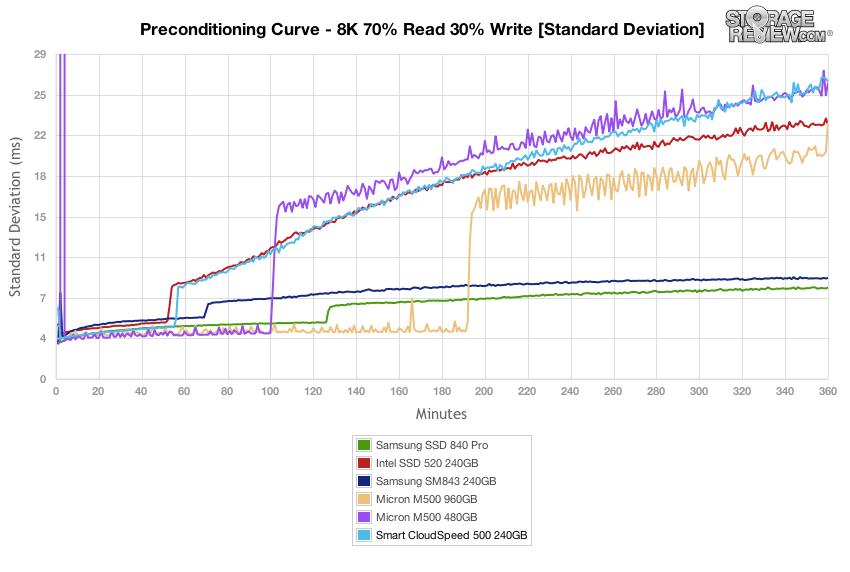
Compared to the fixed 16 thread 16 queue max workload we performed in the 100% 4k write test, our mixed workload profiles scale performance across a wide range of thread/queue combinations. In these tests, we span workload intensity from 2 threads and 2 queue up to 16 threads and 16 queue. In the expanded 8k 70/30 test, the CloudSpeed 500 scaled at the bottom of the group but just above the Intel 520 from 3,999 IOPS at 2T/2Q to 6,103 IOPS at 16T/16Q.
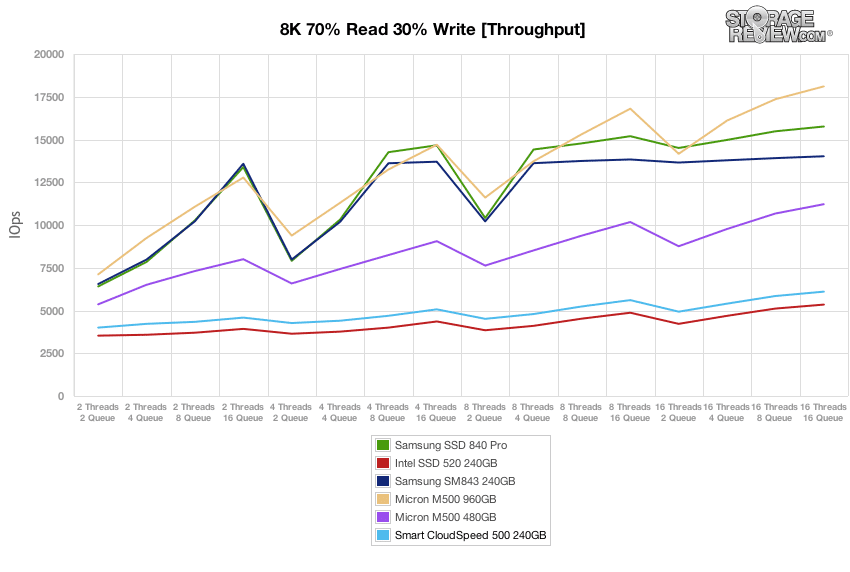
After the SSDs had entered steady-state in our 8k 70/30 test, the CloudSpeed 500 had an average latency of 0.99ms at 2T/2Q which increased to 41.93ms at 16T/16Q.
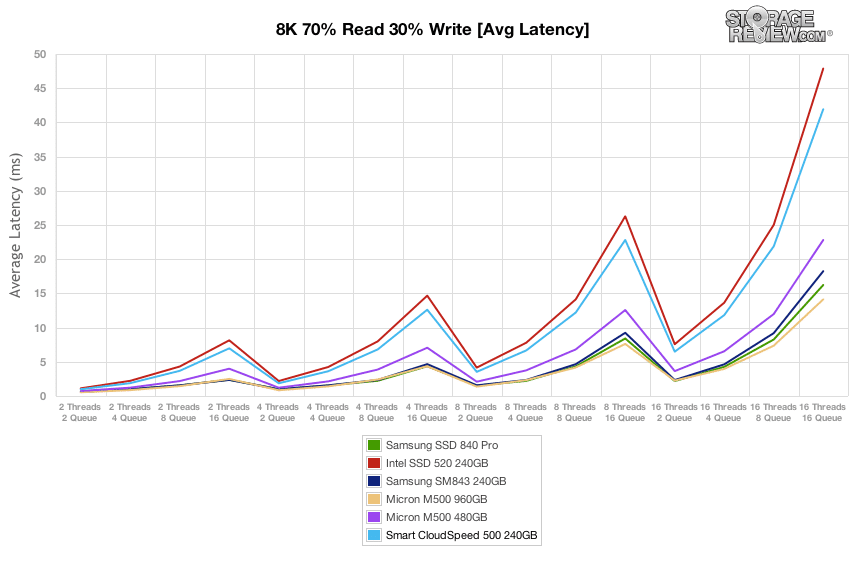
Max latency spiked for most of the queue depths, although it was reigned in by the time it reached 16T/16Q.
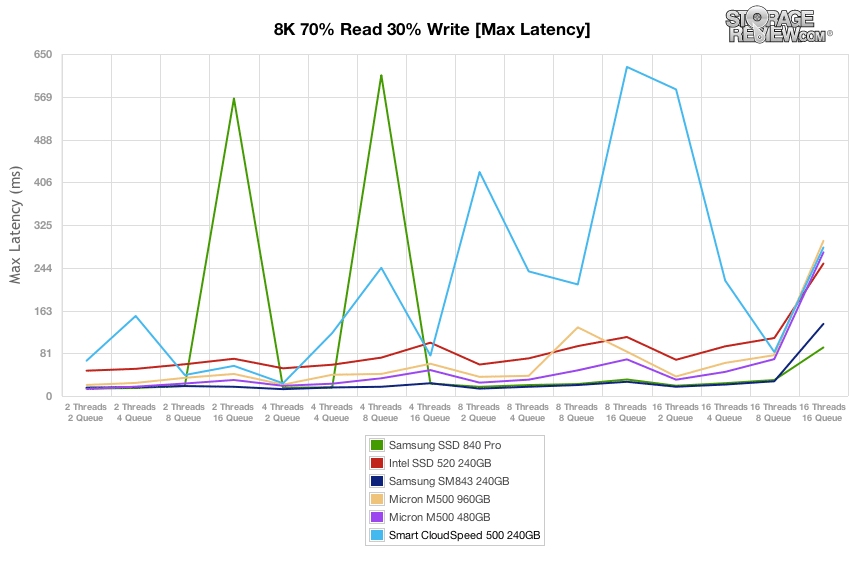
Comparing latency consistency in our 8k 70/30 test, the Samsung drives were essentially in a separate class and the CloudSpeed 500 stayed fairly close to the remaining SSDs.
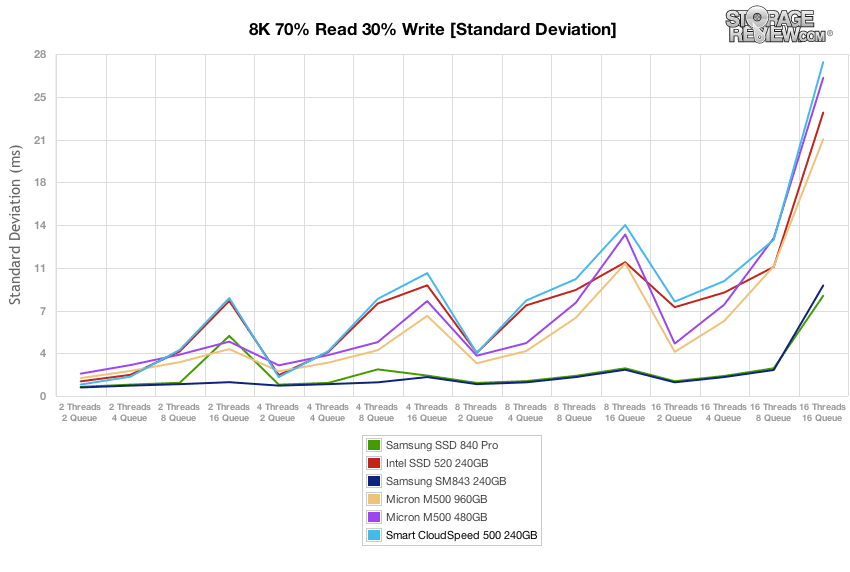
The next workload is our File Server profile, which covers a wide range of transfer sizes spanning from 512b to 512K. With a heavy 16T/16Q saturation load, the CloudSpeed 500 tested with peak transfer speeds measuring 29,000 IOPS before easing into a steady-state speed near 10,000 IOPS. Throughout this workload, the CloudSpeed 500 was in the middle of the pack.
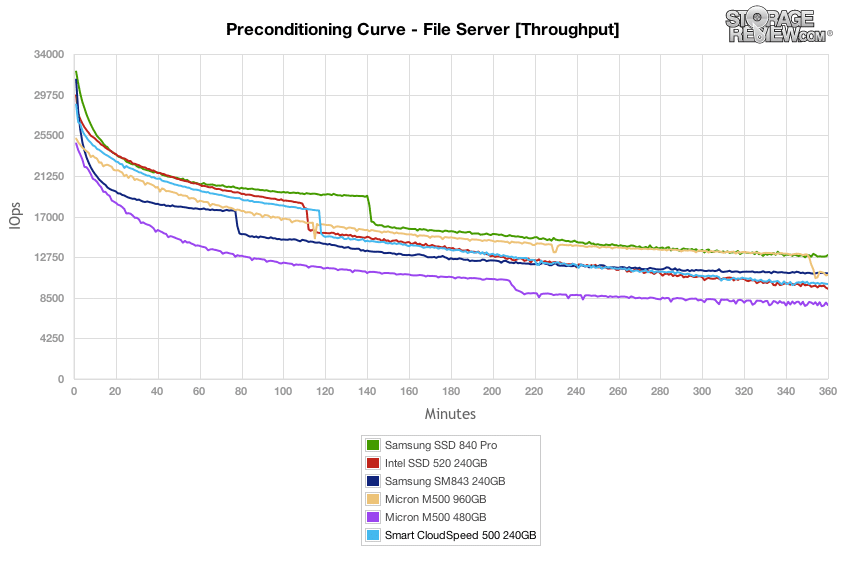
The CloudSpeed 500’s average latency in our File Server preconditioning test measured at 8.85ms in burst before increasing to 25.74ms in steady-state.
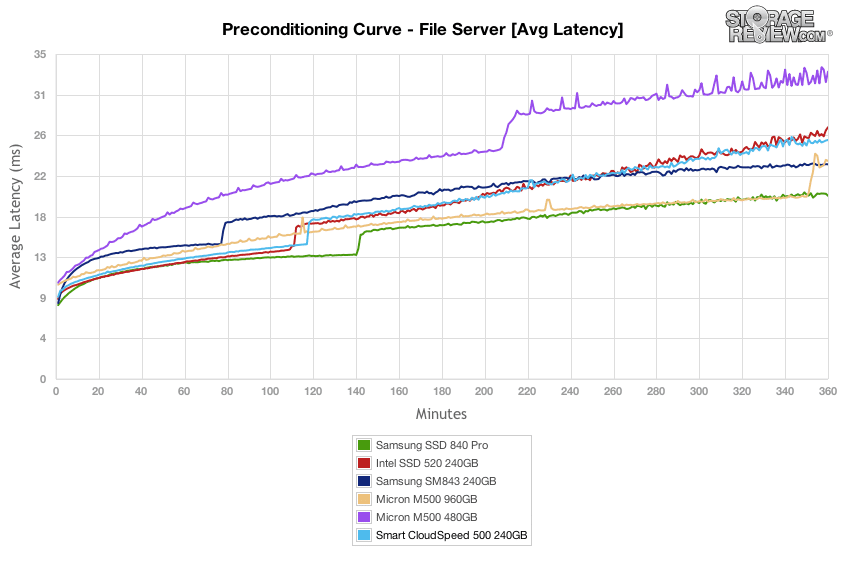
Nearing steady-state in our File Server preconditioning test, the CloudSpeed 500 had max latency ranging from 140-240ms.
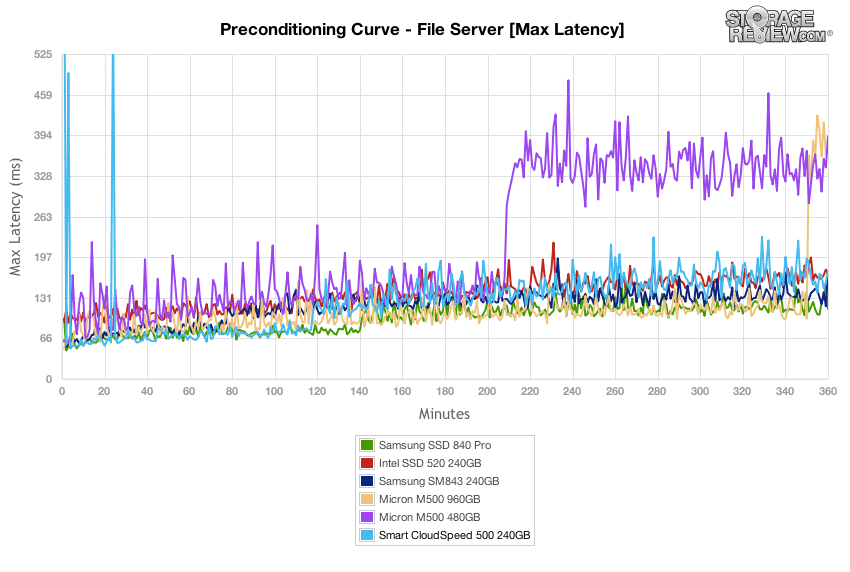
Switching focus to latency consistency in our File Server preconditioning test, the CloudSpeed 500 tested in the middle of the pack throughout.
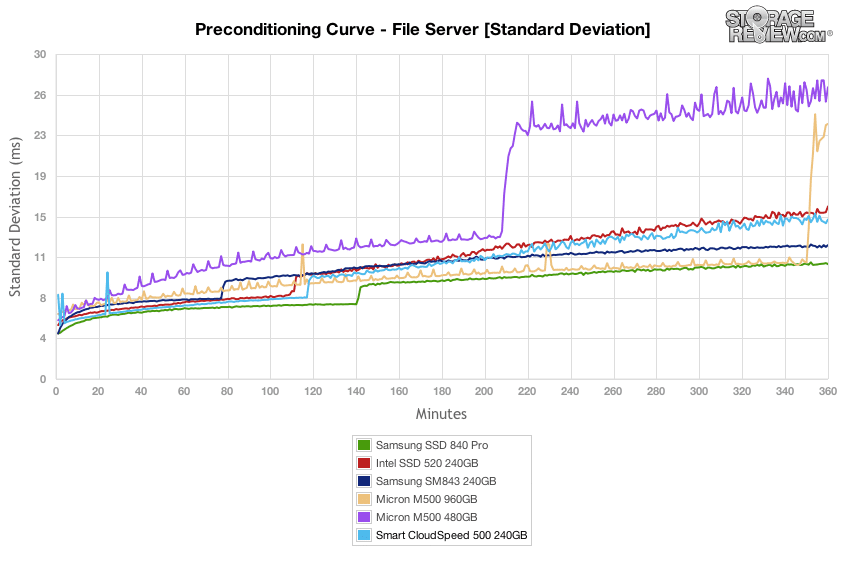
After our 6-hour File Server preconditioning process had finished on each SSD, we transitioned to varied workloads where we scale between 2T/2Q up to 16T/16Q. The CloudSpeed 500 ranked in the middle of the group again scaling from 4,888 IOPS at 2T/2Q and peaking at 9,585 IOPS at 16T/16Q.
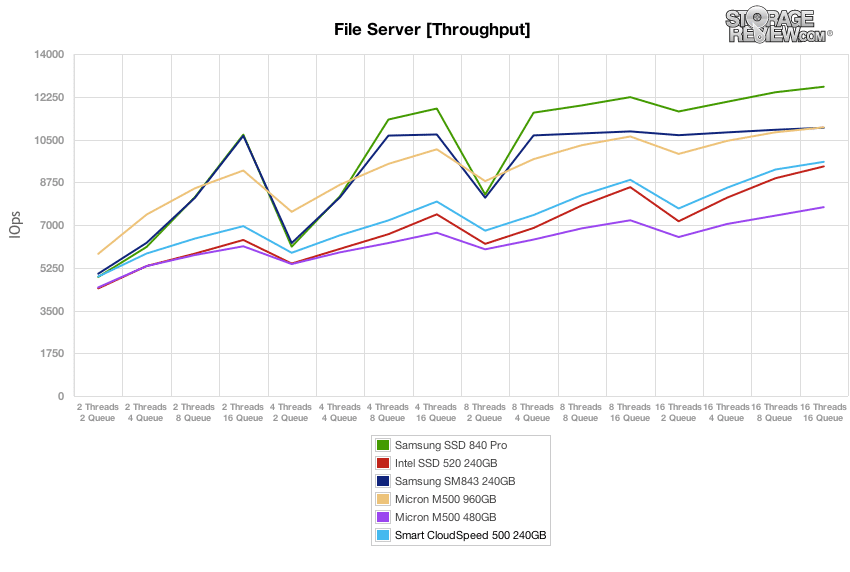
The CloudSpeed 500’s average latency in our File Server test scaled starting at 0.81ms at 2T/2Q and increased to 26.7ms at 16T/16Q.
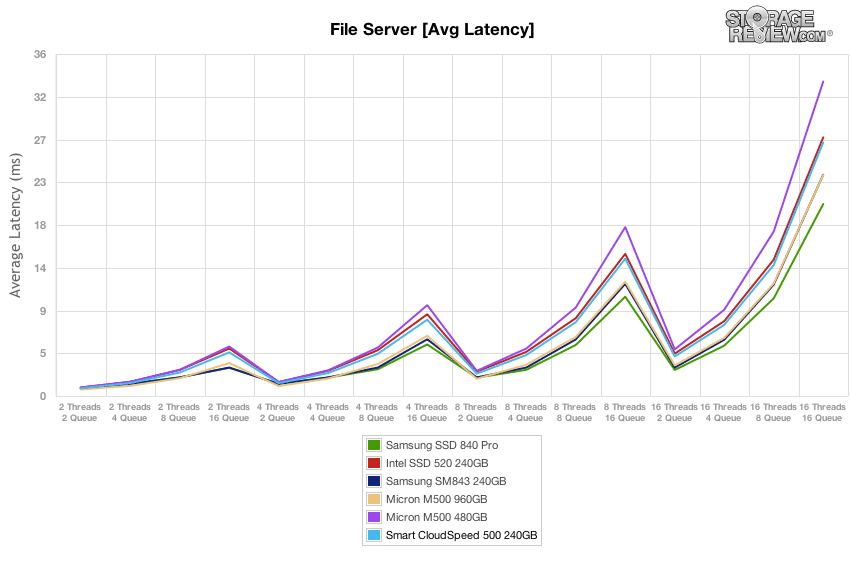
In our File Server test, the CloudSpeed 500 had response times that were middle of the pack across scaling workloads. It started high on a peak at 2T2Q, but leveled off with a few more peaks up until 16T/16Q where it made a final peak at 236.6ms.
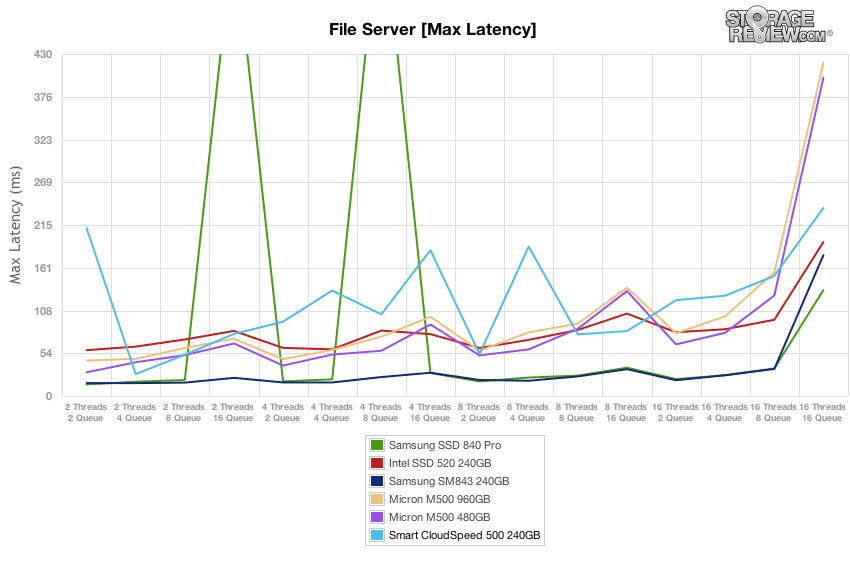
Comparing latency consistency, the CloudSpeed 500 ranked in the middle of the pack with the Samsung drives asserting themselves again.
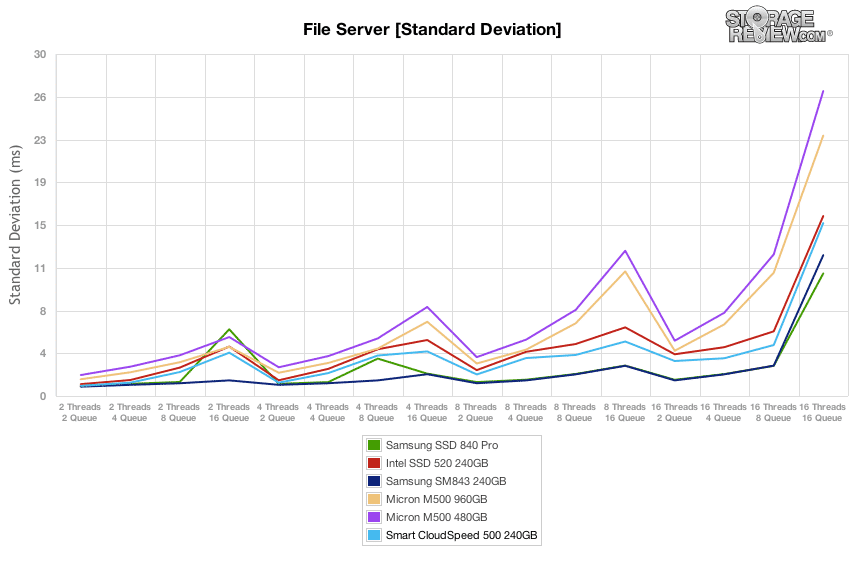
Our final preconditioning workload takes the traditional 100% read activity Web Server test and flips it to 100% write to precondition each SSD. This is our most aggressive workload, although it doesn’t really match any real-world conditions with 100% write. In this section, the CloudSpeed 500 offered the mid-level burst speeds, yet as it arrived at steady-state, it was at the bottom of the SSDs with the Intel 520.
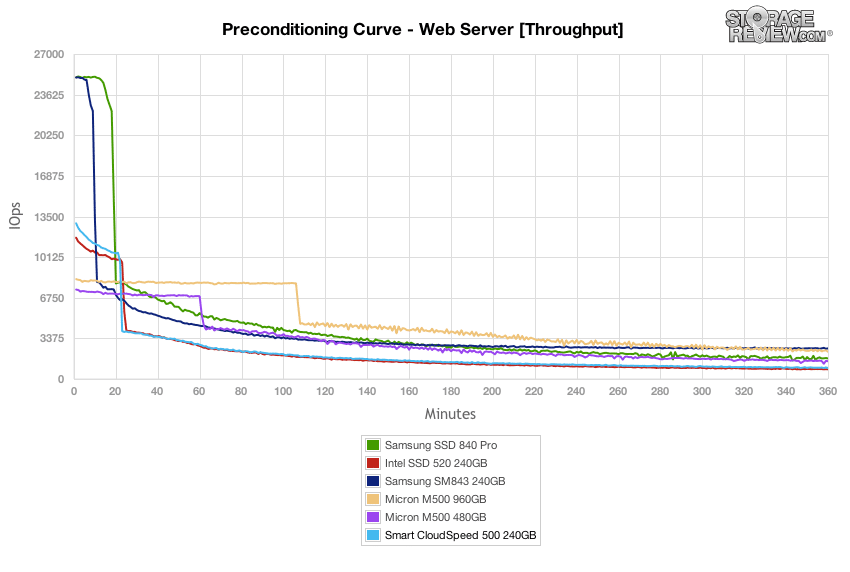
Average latency in our Web Server preconditioning test leveled off around 270ms as the drive neared steady-state, staying higher than all the drives except for the Intel 520.
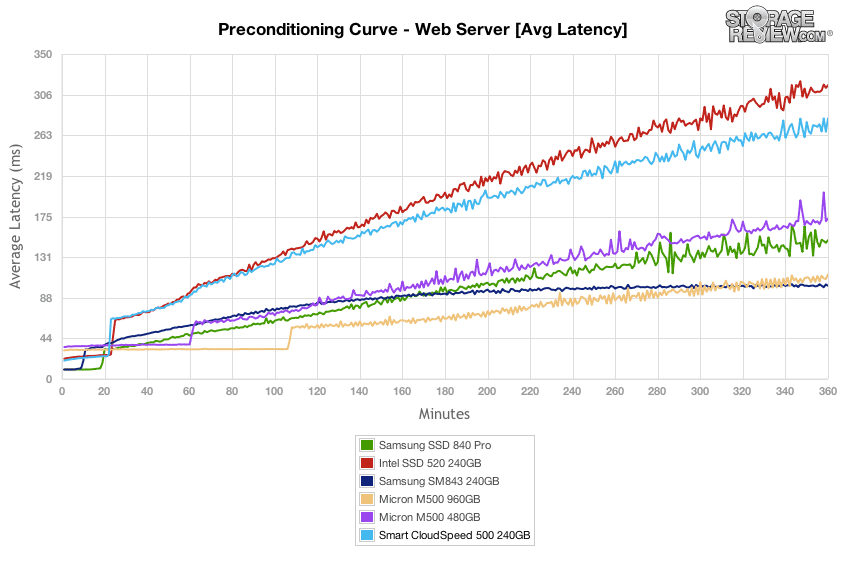
Max latency from the CloudSpeed 500 in the duration of our stressful 100% write Web Server preconditioning run ranged from 800 to about 1,200ms as it neared steady-state, which was near the middle of the group.
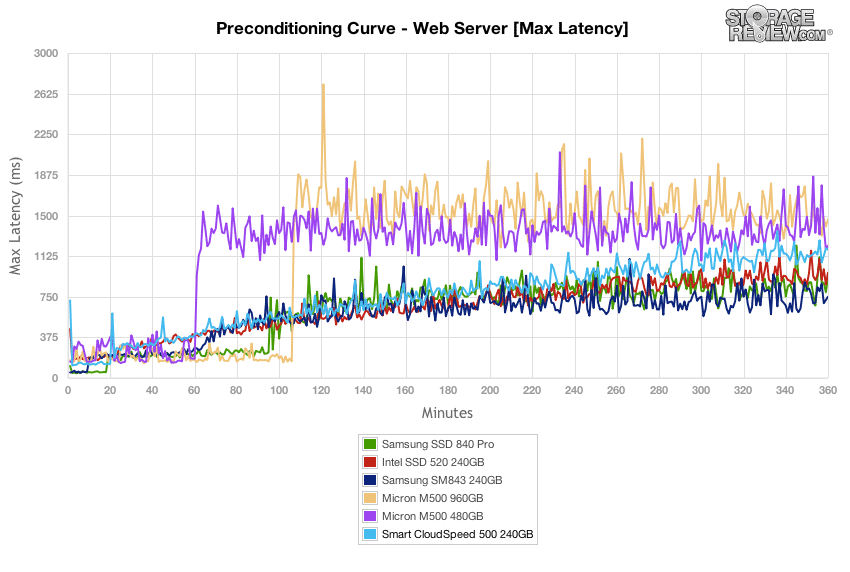
Comparing latency standard deviation in our Web Server preconditioning test, the CloudSpeed 500 performed near the bottom of the pack as it neared steady-state.
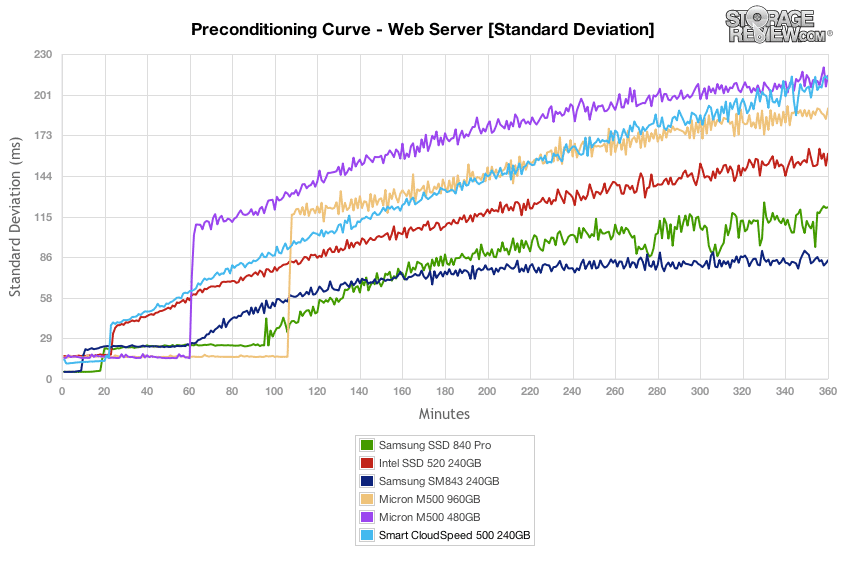
After each SSD finished our preconditioning stage in the Web Server test, we flipped the workload back to 100% read. In read-only conditions the CloudSpeed 500 performed in the middle of the group near the Intel 520 while scaling from 10,150 IOPS at 2T/2Q to 16,674 IOPS at 16T/16Q.
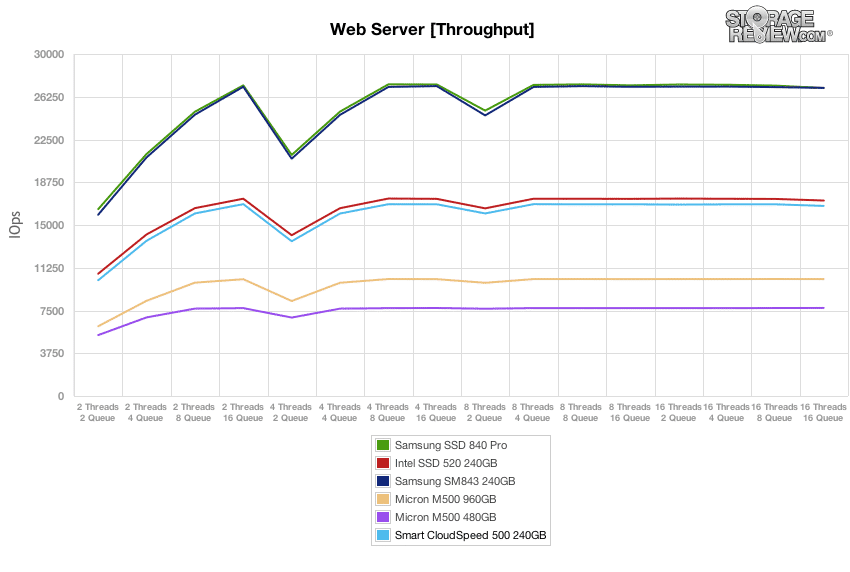
Average latency from the CloudSpeed 500 in our read-only Web Server testing scaled from 0.39ms at 2T/2Q up to 15.35ms at 16T/16Q.
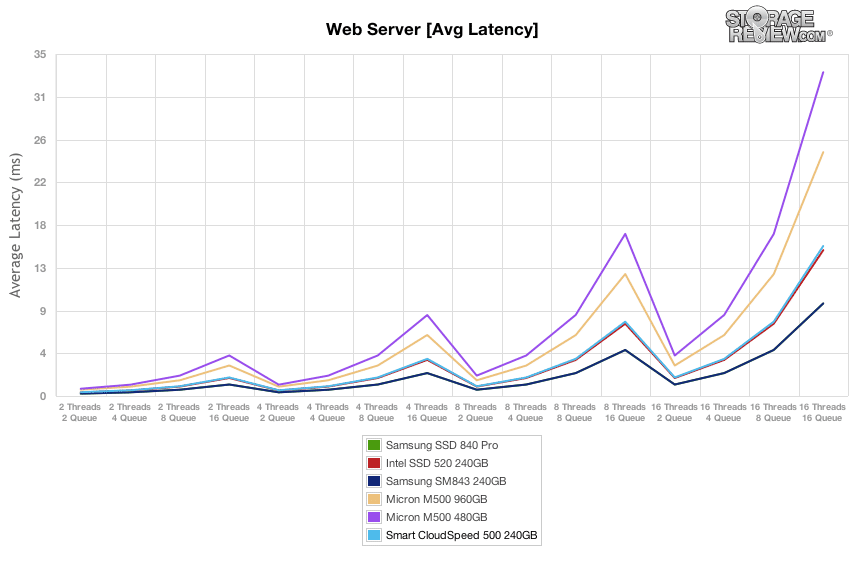
Comparing max latency in our Web Server test, the CloudSpeed 500 had maximum latency measuring around 8.57ms, although it did spike rather drastically to 245.00ms at 16T/16Q.
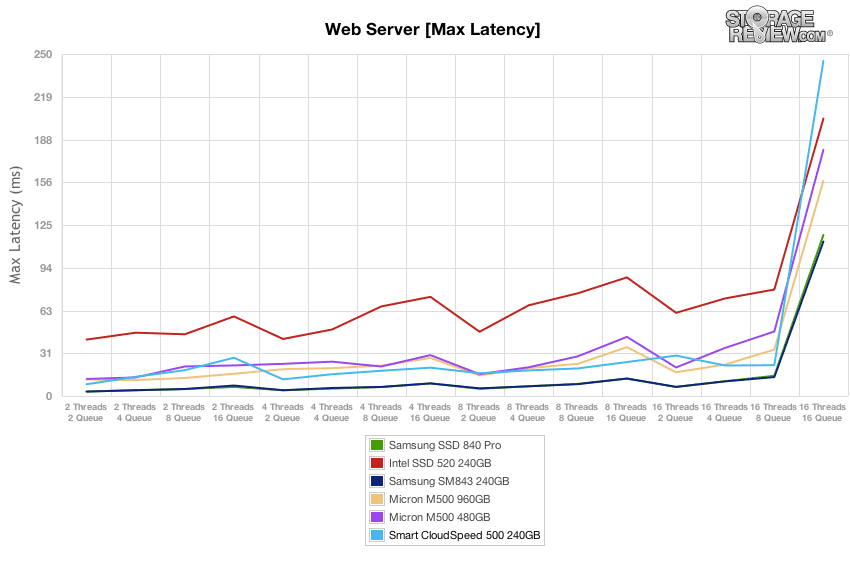
Comparing latency standard deviation in our Web Server test, the CloudSpeed 500 was fairly competitive and placed near the upper-middle of the group.
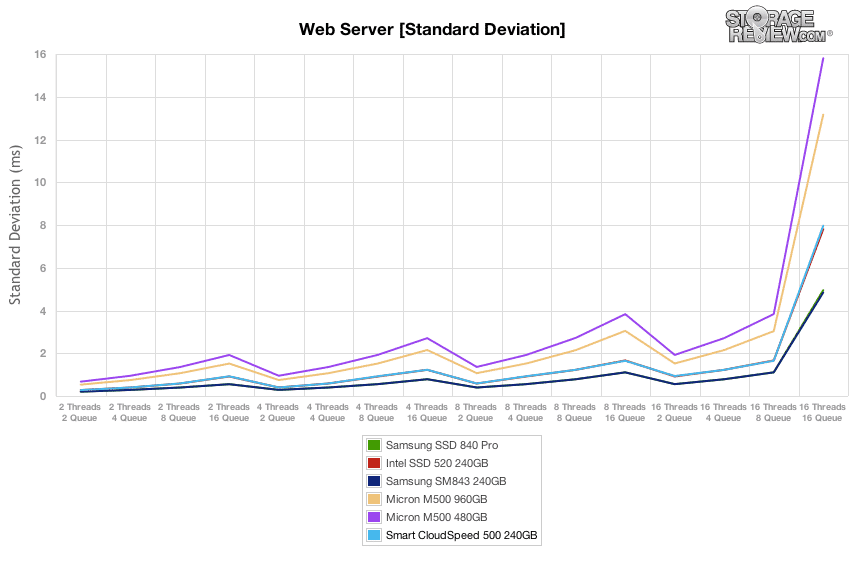
Conclusion
The Smart Storage Systems CloudSpeed 500 is an entry enterprise-class SSD that is designed for environments that are read-heavy but still demand more endurance than a standard client SSD. With that in mind, the CloudSpeed 500 arrives in a 7mm 2.5" form factor with MLC NAND and competes in the server and cloud-computing space. The SSD utilizes only 7% provisioning enabling it to offer capacities at 120GB, 240GB and 480GB. Couple the provisioning with the Smart Storage Systems Guardian Technology Platform enterprise features and endurance enhancement, and the CloudSpeed 500’s are able to provide 15,000 PE cycles.
The Smart Storage CloudSpeed 500 provides performance that isn’t class-leading, but is often in the middle of the tough group in which it was tested. The Samsung drives often proved the strongest in heavy-read workloads while trading places with the M500 in write-heavy workloads. But then we need to peel back to the endurance question, there are significant differences. The M500 is relatively light at just 72TBW, the SM843 is at 1PB and the bulk of the client drives are rated for just three years of operation. The CloudSpeed 500 comes in with 525TBW over the five year warrantied life and adds additional features not found on these competing drives like power-fail protection.
The CloudSpeed 500 has plenty of competition as the market for read-heavy enterprise SSDs continues to expand. Whereas in the past there were only a couple of drives in the space, including many consumer SSDs, many manufacturers are now jumping into the field with specialized drives. They are all attempting to offer a higher level of endurance than was previously offered in the cost-sensitive market, while still offering low latency and strong performance. What it really comes down to is maintaining a low price point. These SSDs don’t need to be top-performers compared to more high-performance SSDs; they need to offer high endurance and reasonable performance while focusing on the issue of cost.
Pros
- High-endurance from MLC NAND
- Universally compatible 7mm z-height
- Higher performance over standard-issue SandForce-based client SSD
Cons
- Middle of the pack performance
Bottom Line
The Smart Storage Systems CloudSpeed 500 is a solid addition to the space of entry-enterprise SSDs. The drive is cost-effective, yet still provides plenty of endurance and enterprise-grade features like power fail protection.




 Amazon
Amazon